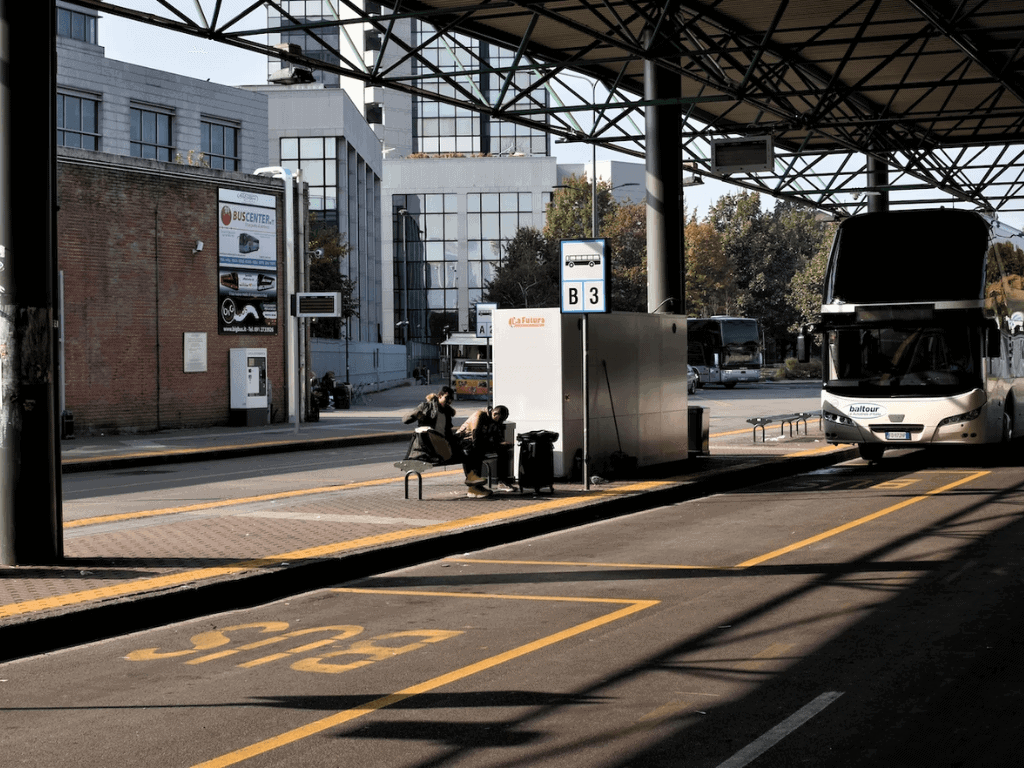Complete Guide to Buses in Europe: How & Why to Travel Europe by Bus
Disclaimer: This article may contain affiliate links. For full information, please see our disclaimer here.
Are you considering traveling in Europe by bus? If yes, you’ve come to the right place! Although bus travel isn’t very common in the United States, taking a long-distance bus in Europe is something every traveler should consider.
But, why travel by bus through Europe when it has an extensive network of trains? Well, it’s convenient, comfortable, and cheap! In fact, bus transportation is one of the cheapest ways to travel around Europe.
🚍 Looking for bus tickets? Search the most extensive inventory of European bus companies here!
Having explored Europe by plane, train, and bus on many occasions, I’ll answer all of your questions in this guide to buses in Europe from why bussing around Europe is a good idea, to night buses, best bus companies, where to buy bus tickets, and more!
Why travel in Europe by bus?

With extensive train networks (some of them high-speed) and many budget airlines, perhaps you’re wondering why anyone would want to travel by bus in Europe. Admittedly, planes and trains are great options, but there are several reasons why taking the bus while you’re traveling or backpacking in Europe is preferable.
First off, bus travel in Europe is typically the cheapest way to get around. Some bus lines even offer deals for booking early or discount certain routes. Best of all, prices don’t fluctuate on the whole. This means you don’t worry about booking in months in advance to get a good deal.
Bus transportation in Europe is also super convenient, which is probably my favorite part. Book your ticket online, head to the local bus depot or meeting point, get in line, and take your seat! By buying a bus ticket, you save all the time (and headache) by not having to get to the airport two hours early, wait to check-in bags you’re afraid you’ll never see again, go through security, and so on. When you add up all the time it takes getting to and from the airport, it’s much easier (and sometimes faster) to take a bus.
While train networks are sophisticated, it’s also important to understand that there aren’t rail lines to every destination. Sometimes, the only way to visit smaller towns is via a bus trip. In this way, taking a bus can allow you to experience more destinations off the beaten path! What’s more, with an extensive freeway and road system in place, new routes are added as needed to take you wherever your heart desires.
Lastly, you get to see the landscape and other towns as you roll by. Seeing what’s in between your departure point and destination can give you a deeper connection and understanding of the place you’re visiting.
Is bus travel safe & reliable in Europe

Bus travel in Europe is safe and reliable. Buses in the EU meet high safety standards. Actually, since 2009, buses are required to be equipped with many of the same features as cars — like lane change assistance and emergency brake assistance. Plus, every driver is certified and trained and must follow strict rules to combat driver fatigue. (This means drivers will take breaks on longer bus trips.) Many of the modern coaches employ seatbelts, which you should wear at all times.
As for reliability, again, the buses meet high standards. You shouldn’t have to worry about a bus breaking down on you. When it comes to timetables, buses typically run on time. Unless there’s a major accident, most schedules take traffic into account. In that respect, always make sure you get to your bust pick up point on time so you don’t miss it!
When it comes to personal safety, it goes without saying that you should exercise caution when traveling, especially if you’re alone. Here are some quick tips for staying safe while traveling by bus in Europe.
- Keep your valuables on your lap or under the seat in front of you, and keep them closed. In other words, this isn’t the time to re-organize your wallet!
- Be especially vigilant at bus stations when crowded or at night.
- Keep an eye on your belongings, specifically when people are getting off the coach. And, there’s a pit stop, don’t leave your valuables on the bus.
Europe Bus Passes
If you’ve been thinking about traveling in Europe, you’ve probably heard that there’s a way to get a rail pass. Rail passes can save you money if you’re planning to do a lot of travel. Simply get a pass through a company like Rail Europe, then book your train tickets on the go.
But, did you know there have historically been a number of bus passes available? If you’re planning on getting around Europe primarily by bus, we’d tell you to consider a bus pass. However, it seems most of the passes are sadly no longer operating due to COVID or other circumstances.
Here are a few companies to keep your eye on just in case they begin issuing bus passes again.
Busabout — Busabout’s Hop-on Hop-off network features 38 destinations in 14 countries. You can build your own route in Europe and make last minute changes with no charge. You’ll get to see the same guides and connect with like minded travelers as well. (Note that due to COVID, Busabout suspended their operations. Check their website for updates.)
Eurolines and Flixbus have also offered bus passes in the past, but there is no information on their websites currently.
Editor’s Note: Don’t forget to insure your trip. Travel insurance can cover trip interruptions, injury, and other mishaps. Don’t leave home without out it; we certainly don’t! Get a quote.
What are buses like in Europe?

Just like different airlines vary in service, bus services in Europe and equipment can vary between bus providers.
For the most part, buses in Europe are outfitted with air conditioning, reclining seats, tinted windows, and curtains. Often, you’ll also have in-seat plugs, entertainment options, music, and if you’re really lucky, wifi. On the longer routes, there are often toilets, too.
Buses run on a set schedule, which repeats itself daily. Sometimes, coaches only leave once or twice a day. Thus, be sure to research your route in advance so you don’t miss your bus.
Just like when boarding a plane, you’re only allowed to bring backpacks or other small items inside the coach. (If they have overhead bins, they’re usually tiny.) You store larger luggage underneath the bus in a special compartment.
You’ll also want to note that sometimes long-distance buses are referred to as coaches. Keep that in mind when looking for signage or attempting to communicate with locals, who may know the word coach or coach station. (If you say bus, they might think you mean city bus.)
How much do buses in Europe cost?

When it comes to ticket prices for buses in Europe, there are a few things to consider.
Depending on the popularity of the route and the individual travel companies, you will see:
- Prices don’t fluctuate much, if at all.
- Depending on the popularity of the route, sometimes peak times are slightly more expensive than off peak.
- Sometimes the cheapest prices (such as those advertised at €1) are for the worst possible time, must be booked in advance, and offer no flexibility.
Here are some examples for prices across some bus routes in Europe.
- Madrid to Valencia €28+
- Paris to London €15+
- Barcelona to Bordeaux €25+
- Lisbon to Madrid €15+
- Rome to Florence €17
- Split to Zagreb €22+
Why to Take Night Buses in Europe

Overnight buses are popular in Europe along certain routes. The advantage to taking a night bus is that you don’t have to spend a day traveling. Instead, you can sleep on the bus, and arrive at your destination the next morning. If you’re on a tight budget, taking an overnight bus will also save you a night’s accommodation.
If you plan to take a night bus, don’t forget to dress comfortably. If you have a travel pillow, a sarong or pashmina (that can act as a blanket), and fuzzy socks, this is the time to get them out. If you can get a window seat — or even better a row all to yourself — you can get a pretty good night’s sleep on a bus.
By all means, book a night bus if you’re up for a new experience!
Where to Book Bus Tickets in Europe

There are several booking engines where you can purchase bus tickets for your trip to Europe either online or by using their apps. We recommend using a booking platform like Omio, so that you can search across all the different region and country-specific bus companies at once.
With Omio, you can search and compare bus schedules/timetables, bus fares, bus companies, seat and ticket types, etc. Even better, you can compare buses and trains to see which is actually the best way to get to your destination. Lastly, you can book and store your mobile tickets on your phone. Read my full review on Omio.
Here are the best options for buying bus tickets in Europe.
- Omio — Book buses by searching the most extensive inventory of European bus companies (also has trains and flights).
- Trainline — Versatile booking platform for trains and buses around Europe with over 200 providers. I usually compare Trainline and Omio, as they will sometimes show different route options.
- Busbud — Online bus-booking platform with millions of bus routes and destinations to help you find low-cost bus routes.
- Comparabus — Compare and book cheap bus tickets on the major service providers in Europe.
- Busradar — Compare bus fares between cities in Europe, which enables you to travel from country to country at a low cost.
What to Bring on the Bus

Since your luggage may need to be checked and stowed under the bus, you’ll want to have quick access to a few essential items when traveling across Europe on a bus. A packable daypack is an especially good option to use as a carry on!
Here’s what to remember to bring with you on the bus.
- Something to occupy your mind — Your laptop, tablet, Kindle or phone loaded with movies, books (For access to your favorite audiobooks, podcasts and originals, try Audible Plus for free.), journal, etc.
- Noise-canceling headphones — Drown out any road or passenger noise for a comfortable ride. In the past, they used to blast movies for everyone to hear, although these days there are sometimes ports for you to plug in your headphones or wifi for you to access your own media.
- Comfortable clothing — Dress in layers as they tend to blast the A/C in buses or not turn them on at all!
- Ear plugs and sleep mask — Whether it’s day time or night time, these are essential to getting some shut eye.
- Portable charger — While some buses have charging ports, they aren’t always reliable. Bring your own portable charger to keep your electronics juiced up.
- Neck pillow, pashmina or sarong — Get comfy, and use your neck pillow for sleeping, a pashmina or sarong as a blanket.
- Anti-nausea solutions — If you’re prone to getting car sick, try some acupressure bands or ginger drops (these are my favorite) for a natural approach.
Do’s & Don’ts of Bus Travel in Europe

Do
- Know where the bus stop/station is — If you have time, go to the bus stop ahead of time. Sometimes, the stations are buildings with ticket counters, cafés, and bathrooms. Other times, they are little more than a parking lot, a collection of bus bays. Scout the stop out ahead of time so you know how long it takes to get there and what to expect.
- Charge your electronics ahead of time — And, bring a portable charger (I can’t tell you how many times the chargers have been broken on travel transport!)
- Wear layers — Be prepared for any temperature, and always have a sweatshirt or packable puffy jacket nearby.
- Water and snacks — Check the rules on the bus, but you can typically bring water. Snacks like nuts and dried meats are mess-free and will keep you full. You don’t want to get stuck without any snacks during meal times.
- Find your assigned seat — Some bus companies will assign seats. If they aren’t assigned, get in line early so that you can get first dibs on seats.
Don’t
- Arrive late — Although sometimes buses are hampered by traffic, they really move! Be there, waiting by the door when it’s time to get on the bus.
- Disturb others — Do not play loud music, talk on the phone, or have loud conversations with your neighbors, especially at night.
- Litter — Use the waste baskets, if provided, or carry an extra plastic bag for trash.
- Schedule tight connections — Leave enough room in between connections. Also, where your next bus or train takes off from isn’t necessarily at the same stop where they let you off. Research ahead of time to make sure you have enough time for transfers.
- Miss your stop — Make sure you pay attention to where you are (using your cell phone’s GPS). Buses only stop for a few minutes. Even better, confirm with your driver where you need to get off ahead of time, and pay attention.
Best Bus Companies in Europe

There are many different bus companies in Europe. Some are regional and others travel on a network of intercity bus services in several countries.
Here are some of the most popular bus lines in Europe.
- FlixBus — The largest transport network in Europe, covering 26 countries. Their modern coaches feature plenty of legroom, power outlets, and free wifi. They have acquired Megabus, too.
- Eurolines — A network of cooperating bus companies and is a popular method of travel between neighboring European countries.
- Regiojet — The main bus company in the Czech Republic and Slovakia with international connections to other major cities.
- National Express — Buses in the UK and long-distance travel in Europe.
- BlaBlaCar Bus (formerly OUIBUS) — A growing network of buses, now the one of the largest in France, that connects to many places in Central Europe.
- Alsa — This is the main bus company in Spain, and it also offers a cheap and convenient way to get to Portugal.
- Avanza — Operates primarily out of Madrid and other major Spanish cities.
In addition to booking with the booking engines we listed above like Omio or Trainline, you can also book coach tickets directly with each bus company’s website. We have found that it’s not always the easiest if you don’t speak the language — even when translated to English, they are sometimes tricky to navigate. However, if they aren’t working with one of these ticket consolidators, you may need to book bus tickets directly.
Negatives of Bus Travel in Europe

Of course, with every pro, there are some cons to bus travel in Europe.
Buses are not as comfortable as trains. To explain, on trains, you can get up and stretch as much as you want, the restrooms are larger, and you can even book a bed on a sleeper train when traveling overnight.
Sometimes bus routes are hard to decipher, especially the smaller regional routes that might not even have websites. Read your ticket carefully or ask for help so that you understand where to get on (remember, it isn’t always at the bus depot), where to transfer, etc.
When it comes to schedules, sometimes the routes are only at night. Others have long layovers or odd transfer locations, causing the total trip duration to be extra long. We suggest you always compare bus and train travel to see if the trip time is worth the savings.
Solo female travelers in particular may want to avoid bus stations or stops at night as an extra precaution.
Buses in Europe FAQ
Are there buses in Europe?
Yes, there are a number of intercity buses in Europe that will take you just about anywhere you want to go.
Are buses cheap in Europe?
If you’re wondering if it’s cheaper to travel by bus or train in Europe, the answer is typically yes. However, it depends on the country and the route. Sometimes train travel is the same or cheaper. Use a site like Omio or Trainline to compare trains and buses across Europe.
How do you buy a bus ticket in Europe?
The easiest way to get a bus ticket for European travel is by booking online using one of the top booking engines like Omio, Trainline, or BusBud. If your preferred provider hasn’t partnered with these third party ticketing providers, you can buy directly via the bus company online or at the station.
Do I need to print my ticket?
Post-COVID, we’re finding that more and more operators are using mobile tickets. When you purchase your ticket, you should have instructions as to whether or not you need to print it out. If you’re unclear on the directions, ask at the reception desk at your hostel or hotel for help.
Are European buses comfortable?
Coach travel in Europe is relatively comfortable. Many have reclining seats, tinted windows, and in-seat power. Toilets are sometimes available, and if they don’t have them, buses will stop every few hours for a break.
Is it safe to take a night bus in Europe?
It’s generally considered safe to take a night bus in Europe, just like it is during the day. Just be sure to keep your valuables on you at all times. You can wear a money belt, or drape your jacket or sarong over your valuables for an extra layer of protection.
Which bus service is the best in Europe?
It depends on the region and/or country, but FlixBus, BlaBlaCar Bus, Eurolines, and National Express are some of the main players when it comes to European coach travel.
How much luggage can I take on a bus in Europe?
Luggage is limited like it is on an airplane. Roller bags and larger backpacks won’t fit in the bus. Depending on the provider, checking luggage underneath the bus is free or the fee is nominal. There may also be a limit on how many bags you can bring.
Can I cancel or change my ticket?
If your plans change, you may be able to cancel or change your ticket depending on the company you are traveling with and the type of ticket purchased. A flexible ticket can often be changed, maybe even refunded. Unless you really need to save money or are sure of your plans, consider buying a flexible ticket.
Where do buses leave from?
Although most buses leave from a bus station, they can depart from stops around the city or even airports. Never assume the bus leaves from a bus station, and give yourself plenty of time to find the stop.
Are there sleeper buses in Europe?
There are no sleeper buses with beds comparable to sleeper trains in Europe. However, there are overnight buses. If you’re lucky, you might even get an entire row to yourself to stretch out.
Do they check passports on buses in Europe?
When you show your ticket to the driver, you will usually show your passport so that the driver can verify your identity. While there aren’t generally checks between Schengen countries, random checks have been reported. In any case, you should always have your passport with you. Also, you may be asked for your passport number when purchasing long-distance train or bus tickets — this is normal.
Do bus drivers speak English?It depends, but I wouldn’t count on it. Downloading Google Translate (Apple or Android) can be a huge help for when you need to communicate in a language you don’t speak.
Is taking a bus in Europe worth it?
In our opinion, European long-distance bus travel can totally be worth it!
On the plus side, traveling by bus is convenient, relatively cheap, and safe. It’s also sometimes the only option to get to the smaller towns you might like to visit. When it comes to buying bus tickets in Europe, there are many online ticketing platforms like Omio that make searching and comparing the best ticketing options pretty seamless.
On the negative side, sometimes the bus journeys are really long! You really have to do a cost-benefit analysis when it comes to routes that will take almost an entire day. Of course, sometimes night buses can alleviate that concern.
If you’re ready to try bus transport in Europe, start searching for a route now!
More Travel Tips & Information
For more information on traveling in Europe, check out these blog posts.
- 20 Safest Cities in Europe
- Best Packable Daypacks
- Omio Review
- Travel Essentials for Women
- Emergency Numbers in Europe
Pin it!

